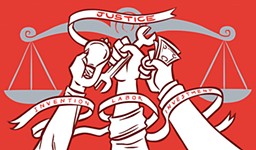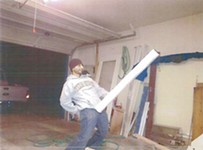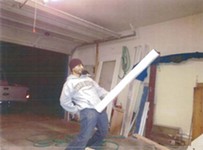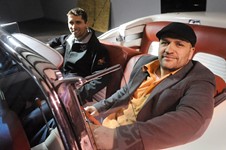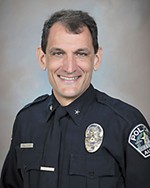APD Infiltrates Occupy
Undercover cops revealed in Houston – Acevedo promises review
By Jordan Smith, Fri., Sept. 7, 2012

Did an undercover Austin Police detective induce members of Occupy Austin to commit felony obstruction of a roadway during a demonstration in Houston in December 2011? Or, did he – and two colleagues – intervene in protester plans in order to keep them, and police and firefighters responding to the Houston protest, safe?
Those are among the questions pending before Harris County district Judge Joan Campbell, who is presiding over the prosecution of Austinite Ronnie Garza, one of 15 Occupy protesters from across the state arrested in December during a demonstration at Houston's port, part of a nationwide "Occupy the Port" action. Garza is among a group of seven of those protesters who are now facing felony charges of "possession of a criminal instrument" as a result of that roadblocking action, while the other eight protesters, who were also blocking the road, were charged only with misdemeanor obstruction of a highway. A misdemeanor is punishable by six months in the county lockup; a felony conviction carries a possibility of two years in a state jail.
At issue for the court was the manner in which each group of protesters blocked the road and who shares responsibility for the action. The group facing the misdemeanor charges locked arms while lying across the roadway; the group facing the felony charges linked their arms with the aid of a "lockbox" (sometimes called a "dragon sleeve"). It's essentially a homemade PVC sleeve made to lock protesters together or to a stationary object and is typically made by drilling a bolt through a width of opaque PVC pipe. Using chain and carabiners, protesters can grasp, or be locked onto, the bolt or each other, their arms hidden snugly inside the pipe. Unless the user releases an arm, the device usually must be cut off, posing risk to the user and, potentially, to the police or firefighters doing the cutting, if booby traps are employed inside the pipe.
It was those concerns about safety, says APD Assistant Chief Sean Mannix, that prompted APD detective Shannon Dowell to get involved last December in constructing a series of lockboxes that the seven protesters were arrested for using at the Port of Houston. Dowell (known to protesters originally as "Butch") was working undercover within the Occupy Austin movement. His real name and occupation were discovered by Garza, investigating a tip that Dowell had gone to high school in Round Rock. Mannix confirmed that the APD actually had three undercover detectives, including Dowell, working inside the movement last year – but the point wasn't to disrupt activities, claims Mannix, but to ensure that any person in Austin wanting to engage in "protected free speech" would be free to do so. (OA activists say the other two undercover cops used the names Rick and Dirk; they haven't yet learned their real names, and the APD declined to reveal them.)
Informants had already told APD that there were some persons inside the movement who were advocating violence, Mannix said, and the idea of having undercover officers attending OA General Assembly meetings and participating in various demonstrations was not to foment trouble or to try to shut down the movement. Instead, he insisted, the strategy was devised solely to ensure the safety of everyone – not only police officers but the protesters themselves. "We are there to protect people who want to engage in protected speech," Mannix said. Dowell and the other two undercover officers had attended General Assembly meetings where the use of lockboxes as acts of civil disobedience were discussed and approved, Mannix said, and Dowell helped to build the devices safely in order to help to keep the protest safe.
Whose Idea Was It?
But Garza strongly denies that there was ever a vote in the OA General Assembly approving the use of the boxes. "The decision to use the lockboxes did not come from the General Assembly, it came from a small planning group which Dowell was a part of," he wrote in an email to the Chronicle. (In the online minutes of the OA General Assembly meetings, lockboxes are rarely mentioned, and there is no recorded vote approving their use in any demonstration.)
Other Occupy Austin activists, including Garza's attorney Greg Gladden, former president of the ACLU of Texas and a member of the National Lawyers Guild, tell a story far different from the APD's official version. According to an affidavit by David Cortez, head of OA's bank actions committee, it was Dowell who encouraged the activists to use the lockboxes. "He was a fairly quiet individual who never contributed much to our meetings," Cortez recalled of Dowell, "but consistently pulled myself and others aside individually in order to express his frustration with debate and eagerness for more aggressive and provocative actions than our standard peaceful & nonviolent ones," reads the affidavit.
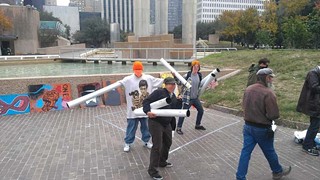
According to the affidavit of fellow OA member Yatzel Sabat, possible acts of civil disobedience, "including trespassing, sit-ins or obstruction of passage ways" had been discussed at meetings but it was Dowell who was involved in the initial discussion of using lockboxes, and it was he who "acted more excited about the idea," reads the affidavit. "He volunteered to gather the piping and other materials by purchasing [them] at Lowe's and delivering [them] back to the members of the group that were planning to go to Houston for the demonstration," she continued. "Butch persuaded us to use these arm tubes."
Sabat and Cortez note that the lockboxes or "dragon sleeves" weren't necessary to carry out the protest; the other eight members who blocked one of the roads leading to the port did so simply with their bodies. And without the influence of the APD officers, Gladden says, the seven now facing felony prosecution, including his client Garza, would have done the same. In short, he says, Dowell's actions entrapped his client and the others, inducing them to take an illegal action they otherwise would not have undertaken. "The police knew the kids could be charged with the felony" for using the lockboxes, Gladden says, "but the kids didn't know [that]."
Judgment Pending
The court must decide whether the activists were entrapped or induced into using lockboxes – which are not illegal to construct or to own, but are illegal when intended for use in a crime – since that in turn allowed the Houston prosecutors to bump the misdemeanor obstruction charge into a felony offense for Garza and his fellow Occupiers.
Based on the transcripts of an Aug. 27 hearing in Campbell's court, the judge has not readily embraced the APD's official story. Dowell was subpoenaed by Gladden to attend the pretrial hearing, and to bring with him all written and electronic records – police reports, text messages, emails, pictures, and notes – related to his Occupy assignment. But Dowell showed up, essentially, empty-handed. He had photos on a thumb drive of the boxes and the woman he delivered them to, he testified, but he somehow lost that drive on the way to court; he had emails on a work computer (and, it seems, on a personal computer as well) and phone messages, but said he had deleted them. He brought with him only "a little note that I made here regarding [an Occupy] meeting," he said. There are no written police reports, he said; since there was no criminal investigation ongoing, there was no reason to write an official report for the APD system, he testified. Judge Campbell did not seem impressed: "When he is sent a subpoena and he doesn't respond and he doesn't come with his own attorney," she said, "I think they lose a little bit of the dignity that they should be carrying themselves with."
At the end of last week's hearing, she told prosecutor Joshua Phanco that the state must produce the names of Dowell's undercover APD cohorts or see the case dismissed. The two other officers are fact witnesses who could help determine whether the police induced the activists' use of the lockboxes. On Wednesday, those names were provided to the court for the judge's private inspection. Also provided were documents related to the APD's undercover mission, though court watchers said that some of those documents were redacted – which did not appear to make Campbell happy. A motion was also filed to quash the subpoenas for the APD's undercover officers, including Dowell, to appear in court, though the judge has not yet ruled on that request. Campbell has again reset the hearing, for Sept. 25, in order to give her time to review all of the relevant documents.
Garza says he isn't surprised the case has been reset – he's been dealing with this for eight months now – but he's upset that the state hasn't yet decided that theirs is a losing case. "I feel that this is excessive on the part of the Austin Police Department and the Houston district attorney's office, how forcefully they're trying to punish a sit-in."
Regardless of the outcome, Mannix says the APD's involvement in Occupy was motivated by a desire to protect free speech, not to impede it. Gladden doesn't see things that way. "It's an old story," he says – as old as the FBI's notorious Counter-Intelligence Program's hunt for subversives, communists, and civil rights activists. "Basically, it's just a chilling effect, that's what they're trying to do."
But APD Chief Art Acevedo insists that his department has no desire to undercut free speech. At the time that the undercover officers were asked to "observe and report" goings-on within OA, dozens of people were sleeping daily at City Hall, and "criminal activity" among that group had begun – including incidents of assault. The APD "would've been remiss if we hadn't put anyone in there to monitor, report, or to stop any criminal activity," he said. The trouble wasn't coming from the "core Occupiers," he emphasized, and the department has "an absolute duty to protect First Amendment activity."
Beyond that, Acevedo says allegations that Dowell constructed and provided the lockboxes to protesters is under review. "Those activities, as reported, went beyond the scope of the mission" to observe and report "that was established at the executive level," he said. "And we are reviewing the matter, from top to bottom," he concluded, to see where the mission might have gone astray, in order to keep anything like that from happening in the future.
Got something to say on the subject? Send a letter to the editor.






